
Paul Hertz



Hubble spots possible water plumes erupting on Jupiter’s moon Europa
Astronomers using NASA’s Hubble Space Telescope have imaged what may be water vapour plumes erupting 125 miles (200 kilometres) off the surface of Jupiter’s moon Europa. Europa has a huge global ocean containing twice as much water as Earth’s oceans, but it is protected by a layer of extremely cold and hard ice of unknown thickness.

LISA Pathfinder success paves way for space-based gravitational wave detection
LISA Pathfinder, a mission led by the European Space Agency with contributions from NASA, has successfully tested key technology needed to build a space-based observatory for detecting gravitational waves. These tiny ripples in the fabric of space, predicted by Albert Einstein a century ago, were first seen last year by the ground-based Laser Interferometer Gravitational-Wave Observatory (LIGO).

NASA’s Kepler mission announces largest collection of exoplanets ever discovered
NASA’s Kepler mission has verified 1,284 new planets — the single largest finding of planets to date. Of the nearly 5,000 total planet candidates found to date, more than 3,200 now have been verified, and 2,325 of these were discovered by the space telescope. Launched in March 2009, Kepler is the first NASA mission to find potentially habitable Earth-size planets.

Searching for distant and wandering worlds
In a global exoplanet observation experiment, NASA’s Kepler K2 mission and Earth-based observatories on six continents hope to survey millions of stars toward the centre of our Milky Way galaxy. Using a technique called gravitational microlensing, scientists will hunt for exoplanets that orbit far from their host star and for free-floating exoplanets that wander between the stars.

Introducing WFIRST — NASA’s wider set of eyes on the universe
With a view 100 times bigger than that of the Hubble Space Telescope, NASA’s Wide Field Infrared Survey Telescope (WFIRST) will aid researchers in their efforts to unravel the secrets of dark energy and dark matter, and explore the evolution of the cosmos. It also will discover new worlds outside our solar system and advance the search for worlds that could be suitable for life.
